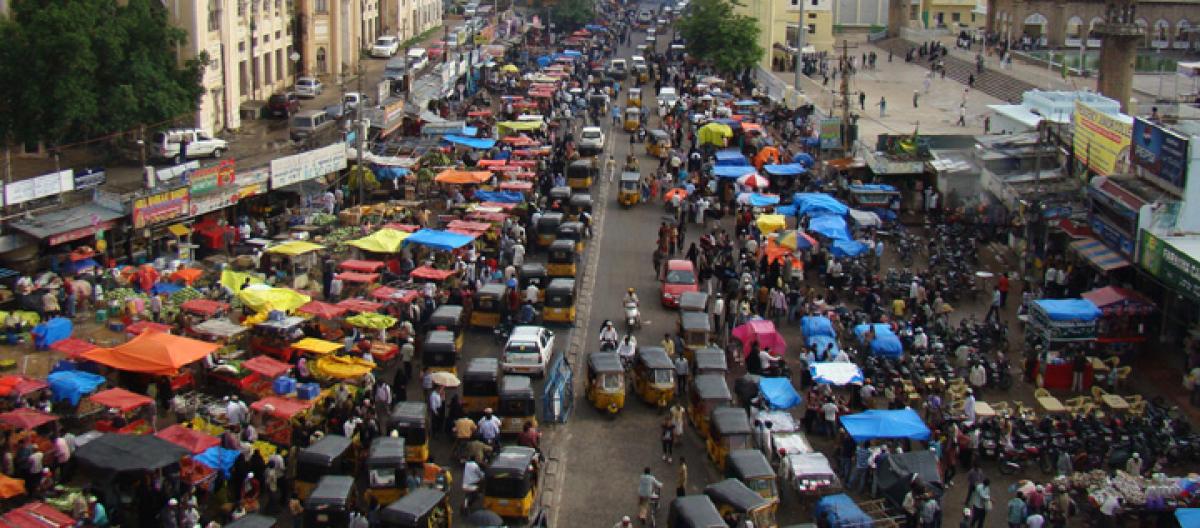Live
- Japan: Citizens protest US military-related sexual violence
- Buy on dips strategy working well in Indian stock market amid sharp rebound
- Sri Lanka concludes sovereign bond restructuring
- Lal Krishna Advani hospitalised at Delhi's Apollo Hospital
- Modi performs puja at Triveni
- Jammu records season’s lowest minimum temperature as Kashmir valley shivers
- Scheme to give Rs 1K to women to be rolled out in 15 days
- Flirty Texts That Turn into Dates
- ‘Asli’ Sonakshi shares a glimpse of herself in ‘golden hour’
- Shraddha Kapoor took ‘thepla’ for her ‘foreign’ trip
Just In

Hyderabad’s tale is different from other metro cities in India. Situated on the top, at 600 metres above sea level, it has a moderate climate all through the year. It is nurtured on moderate resources. Water, the elixir of life, and a lifeline for human settlements, is also available in moderation.
In 2016, we see a clogged city, congested and claustrophobic, polluted and contaminated. More than half the residents depend on undependable sources of water. They spend almost 30 per cent of their earnings on water and 20 per cent more on water-related diseases (due to quality issues and lesser per capita drinking water availability). Transport is another area of bleeding cost
Hyderabad’s tale is different from other metro cities in India. Situated on the top, at 600 metres above sea level, it has a moderate climate all through the year. It is nurtured on moderate resources. Water, the elixir of life, and a lifeline for human settlements, is also available in moderation.
The earlier rulers of the city did create a water storage system, that did adjust itself to the natural water cycle, of rain, seepage, storage, transpiration and river flows. Numerous tanks, storehouses of water, were created, and a few more natural, to sustain this water system.
Floods in 1908 spurred action on water drainage systems. It was a necessity given the undulating, sloping and alternately hilly terrain. Leaving a space of more than 1 km width to River Musi and its inflows was the first such accommodation.
However, greenery and non-nurtured vegetation was also encouraged along the banks of this river. Embankments, using chiseled rocks, were constructed within the city environs, clearly separating water flows from roads and habitations.
Two drinking water reservoirs were constructed upstream of Hyderabad to accommodate initial flows of rainfall in monsoon season. Even downstream anicuts at regular intervals diverted water flows into tanks of nearby villages.
Arterial storm water drains were laid to transfer rainfall into the River Musi, leaving out any scope for inundation of residential areas. Entire system was a good example of urban drainage system. Roads were wide and appropriate. Bridges linked the city on either side of River Musi.
A number of open spaces, including parks, cluster of trees, acted as thermo controls, even when the Deccan temperature soared in summers. Residents of Hyderabad were happy. First signs of trouble in Hyderabad could be seen in 1987 when water scarcity occurred.
People blamed it on population growth. Since then on, the deterioration of an efficient city began, and it gathered pace in late 1990s. Building rules were brought in 1989, and have been continuously changed, reformed and relaxed to suit the powerful.
Several amendments in the last 25 years, periodically, have failed to stop the destruction and concretisation. In the process, open spaces vanished, water resources were encroached, including tanks, nalas and streams. Roads became narrow and congested.
Once a model city in slum management, Hyderabad gradually overcame its accommodative culture and has ignored its poor for the past more than a decade. Housing for middle class communities gradually shifted from independent house to an apartment in a multi-storied building.
Now, poor are also being cajoled to move into apartments, despite their living conditions being antithetic to such buildings. Parks became buildings, tanks became hutments and got converted to apartments, open spaces became either shopping complexes, or multiplexes.
In the process, culture of the city became a victim first, health came next and individual household economy is in a shambles now. Water that was free, sweet and healthy, has become expensive and contaminated.
Hyderabad became a monster-gobbler of natural resources, taking water, sand, land and skilled human resources, of surrounding areas. Surrounding districts of Telangana have become feeding regions, while Hyderabad is merely spreading pollution, dirty waters and solid waste.
In 2016, we see a clogged city, congested and claustrophobic, polluted and contaminated. More than half the residents depend on undependable sources of water. They spend almost 30 per cent of their earnings on water and 20 per cent more on water-related diseases (due to quality issues and lesser per capita drinking water availability).
Transport is another area of bleeding cost. In general, cost of living has soared. As a result, every year more number of people join the group of residents who cannot pay rental value, leave alone reaching their dream of buying a plot of land.
Government decisions enabled a few to make money, and in turn this money became a factor in deciding the usage of land, water and public resources. Hyderabad is being subsidised by State Exchequer, burdening citizens of the State. It has become an instrument to convert public resources into private assets.

© 2024 Hyderabad Media House Limited/The Hans India. All rights reserved. Powered by hocalwire.com







